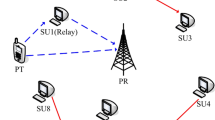Abstract
In Cognitive Radio (CR) networks, cooperative communication has been recently regarded as a key technology for improving the spectral utilization efficiency and ensuring the Quality of Service (QoS) for Primary Users (PUs). In this paper, we propose a distributed joint relay selection and power allocation scheme for cooperative secondary transmission, taking both Instantaneous Channel State Information (I-CSI) and residual energy into consideration, where secondary source and destination may have different available spectrum. Specifically, we formulate the cognitive relay network as a restless bandit system, where the channel and energy state transition is characterized by the finite-state Markov chain. The proposed policy has indexability property that dramatically reduces the computation and implementation complexity. Analytical and simulation results demonstrate that our proposed scheme can efficiently enhance overall system reward, while guaranteeing a good tradeoff between achievable date rate and average network lifetime.
Similar content being viewed by others
References
S. Haykin. Cognitive radio: brain-empowered wireless communications. IEEE Journal on Selected Areas in Communications, 23(2005)2, 201–220.
J. N. Laneman, D. N. C Tse, and G. W. Wornell. Cooperative diversity in wireless networks: efficient protocols and outage behavior. IEEE Transactions on Information Theory, 50(2004)12, 3062–3080.
K. B. Letaief and W. Zhang. Cooperative Communications for cognitive radio networks. Proceedings of the IEEE, 97(2009)5, 878–893.
G. Ganesan and Y. Li. Cooperative spectrum sensing in cognitive radio, Part I: Two User Networks. IEEE Transactions on Wireless Communications, 6(2007)6, 2204–2213.
J. Mietzner, L. Lampe, and R. Schober. Performance analysis for a fully decentralized transmit power allocation scheme for relay-assisted cognitive-radio systems. IEEE Transactions on Wireless Communications, 8(2009)10, 5187–5201.
K. Lee and A. Yener. Outage performance of cognitive wireless relay networks. In Proceedings IEEE Global Telecommunications Conference (GLOBECOM), San Francisco, 2006, 1–5.
Y. Xing, C. N. Mathur, and M. A Haleem. Priority based dynamic spectrum access with QoS and interference temperature constraints. In Proceedings IEEE International Conference on Communications (ICC), Singapore, 2006, 4420–4425.
X. W. Gong and W. Yuan. A cooperative relay scheme for secondary communication in cognitive radio networks. In Proceedings IEEE Global Telecommunications Conference (GLOBECOM), New Orleans, 2008, 1–6.
D. Berstimas and J. N. Mara. Restless bandit, linear programming relaxations, and a primal dual index heuristic. Operations Research, 48(2000)1, 80–90.
D. Chen, H. Ji, X. Li, et al.. A novel multi-relay selection and power allocation optimization scheme in cooperative networks. IEEE Conference on Wireless Communications and Networking (WCNC’10), Sydney, 2010, 1–5.
H. S Wang and N. Moayeri. Finite-state Markov channel-A useful model for radio communication channels. IEEE Transactions on Vehicular Technology, 44(1995)1, 163–171.
P. Hu, Z. Zhou, Q. Liu, et al.. The hmm-based modeling for the energy level prediction in wireless sensor networks. In Proceedings IEEE 2nd Conference on Industrial Electronics and Applications, Harbin, China, 2007, 2253–2258.
Author information
Authors and Affiliations
Corresponding author
Additional information
Supported by the National Natural Science Foundation (No. 60832009), the Beijing Municipal Natural Science Foundation (No. 4102044), and the National Natural Science Foundation for Distinguished Young Scholar (No. 61001115.
Communication author: Chen Dan, born in 1986, female, Ph.D..
About this article
Cite this article
Chen, D., Ji, H. A distributed cooperative relaying optimization scheme for secondary transmission in Cognitive Radio networks. J. Electron.(China) 28, 8–14 (2011). https://doi.org/10.1007/s11767-011-0523-y
Received:
Revised:
Published:
Issue Date:
DOI: https://doi.org/10.1007/s11767-011-0523-y




